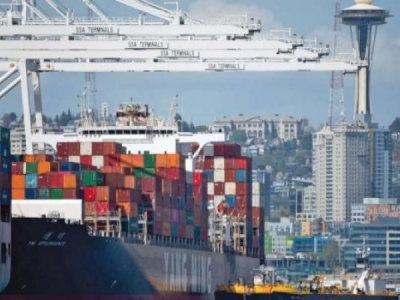
Posted on April 22, 2020
While the coronavirus has hurt international trade at U.S. ports, the movement of goods between the Pacific Northwest and Alaska remains healthy.
“Alaska is our largest market in our domestic trade, accounting for approximately 80% of domestic containerized cargo. We are the lifeline for people in Alaska. In fact, Puget Sound’s trade with Alaska is estimated at more than $5 billion. In March, we saw an 11% year-over-year increase in our Alaska volumes driven by a spike in demand for grocery supplies by major retailers,” said Northwest Seaport Alliance (NWSA) Chief Executive Officer John Wolfe.
Port of Seattle Commission President Peter Steinbrueck said Alaska is “highly, highly dependent” on receiving goods shipped from the NWSA’s seaports of Seattle and Tacoma, Washington.
“These essential items for Alaska include groceries, consumer goods, automobiles, construction equipment, materials and supplies, and so forth on the inbound. Outbound, Alaska sends seafood. We’re gearing up for the big seafood season. There are many uncertainties right now. We’re trying to work through them to maintain that operationality. Hopefully the economic challenges can be overcome here as well with regard to keeping things flowing,” Steinbrueck said.
Jim Jager, external affairs director for the Port of Alaska, said, “Shippers have plenty of capacity to handle additional seafood cargo and they should not feel too much financial pain if COVID-19 significantly reduces 2020 commercial fishing harvests.”
Jager said TOTE Maritime and Matson deliver the majority of food and consumer goods to Anchorage twice a week.
“These vessels depart the Port of Tacoma on Wednesdays and Fridays and take a little less than three days to reach Anchorage, depending upon weather and tides,” Jager said. “TOTE services Alaska with two ships that sail directly between Tacoma and Anchorage. Matson uses three ships that also provide twice-weekly service to Kodiak and once-weekly service to Dutch Harbor.
“TOTE and Matson have maintained normal Alaska shipping schedules throughout the COVID-19 pandemic,” Jager continued. “The Port of Alaska noticed a slight seasonally adjusted increase in container volumes in late March/early April as local retail managers adjusted their orders to accommodate COVID-19 shopping patterns, but that surge seems to be settling back to normal as local retail stores restock their shelves.”
“It’s critically important that we keep this gateway functioning at a high level and there is confidence this gateway is going to stay open. Each and every day we are reaching out to the industry and all the stakeholders to be part of the solution and recovery in the very near term,” Wolfe said.
“It’s critical that we continue to provide the transportation infrastructure that’s necessary in this global crisis — medical supplies, foodstocks, equipment, a whole range of things that come through our ports. We have a critical role here in terms of ensuring that continuity in the supply chain.”
Source: finance.yahoo.com





